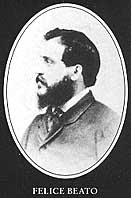Beato Felice

Beato, Felice (Felix) (1834-1908?) Corfu Island, Greece.
One of the first foreign photographers to settle in Japan after the country opened up to the West in the 19th century. He is the most famous early photographer in Japan and left behind a priceless body of work showing the people and landscapes of 19th century Japan.
Thought to be a British national. Worked as a press photographer in England and gained fame by covering conflicts such as the Crimean War in 1855, Indian Mutiny in 1858, and the occupation of Peking, China by Britain and France in 1860.
By mid-1863, he was living in Yokohama. Formed a partnership with British artist Charles Wirgman whom he met in China. They established companies Beato & Wirgman, Artists & Photographers, and later F. Beato & Company. He traveled extensively in Japan and accumulated many photos of Japan which he sold commercially. He became one of the originators of "Yokohama Shashin" tourist photos. Also photographed the opening of Japan's first railway between Tokyo's Shimbashi and Yokohama in 1872.
In 1863, he managed to photograph Edo which was accessible only to foreign diplomats. In 1864, he was the official photographer sailing on the British flagship of the British squadron to Shimonoseki where Choshu clan forts had been firing upon Western merchant ships. By the time Beato arrived, the forts were already disabled by the Western powers and Beato photographed the captured guns.
In 1866, a major fire in Yokohama claimed much of his photo stock. Beato then worked for a year to try and replace the lost photos. He operated his studio, F. Beato and Company, from 1869 until 1877 when he sold his stock to Baron Raimund von Stillfried's Japan Photographic Association.
Besides photography, he pursued other business enterprises in Japan. He was a partner in Yokohama's Grand Hotel, a local and frequently photographed landmark. Also owned and rented out apartments in Yokohama's foreigner settlement.
After 20 years in Japan, he left in Nov. 1884. The newspaper reported that he had suffered a major loss in trading silver and his family had to pay for his passage. In the years following, he went to Sudan and England to photograph wars there, and moved to Rangoon, Burma in 1887 and established a few businesses. He left behind a remarkable photographic record of 19th-century Japan. (2005.06.07)
Written by Philbert Ono